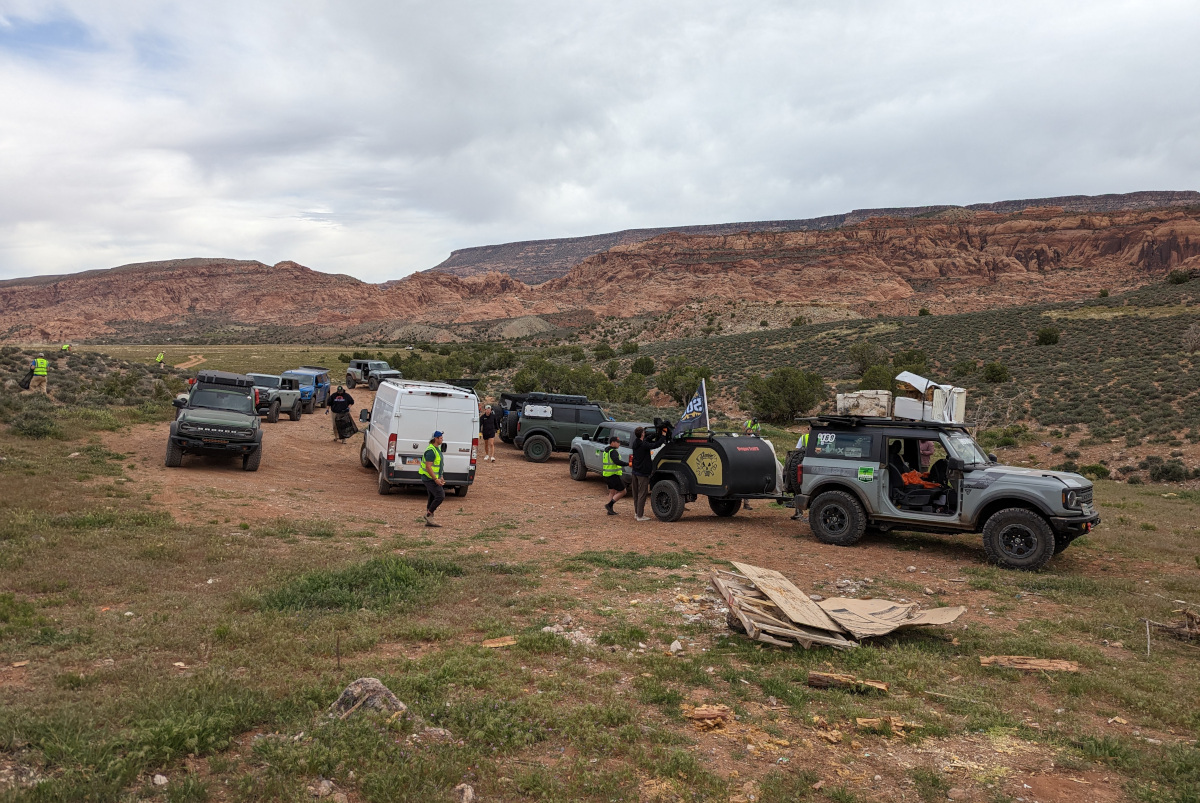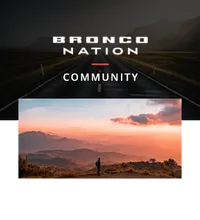Going off-road requires more than having the grippiest tires or clearance to conquer boulders — it’s also about being a good steward of the land and outdoor community. Whether you’re new to the trails or just need a quick refresher, these basics will help keep your adventures fun and friendly for everyone.
Non-Negotiables | What Everyone Must Do
Check Your Vehicle Before Every Trip
Pre-run inspections are key. After every trip, you should be cleaning your Bronco and checking for damage, but it’s good to do a once-over before your next. Top off fluids and make sure you have all your gear: Bring recovery equipment, food, water, sunscreen — and double-check your last ride didn’t leave your Bronco needing repairs. Don’t hit the trail relying on someone else to bail you out if you already know something’s broken.
Follow Tread Lightly! Principles

Always stay on the designated trail. In open ride/scramble areas like Sand Hollow or Johnson Valley, you might have more freedom, but etiquette still applies. Leave no trace, pick up any trash you see, and never toss anything, even biodegradable items like fruit peels. If you see something too big to haul back that day, mark it on the Sons of Smokey app, and consider your next club outing as a chance to go back and get it. Bring WAG bags, spill kits, and always pick up after your pets.
Have the Right Permits and Stickers
Don’t be that person. Make sure your vehicle is compliant with local rules and regulations. Pay the fees, get your permits and flags, and set the example for responsible wheeling.
Obey Signs, Speed Limits, and Closures + Use Common Sense
Speed has its time and place — but not where it's restricted. You never want to endanger others by disobeying the law. Stay alert for posted limits, trail closures, and roadblocks. Even where there is no posted limit, make sure you can stop in half the distance you can see. If a gate is open or closed, leave it how you found it unless signage says otherwise. Know your vehicle’s width, too. If the trail is meant for ATVs or bikes, don’t try to sneak through or widen the path.
Respect the Terrain and Seasons

Avoid rutting trails to get through obstacles. Air down, winch, or turn back if needed. Rock stacking is sometimes necessary, but altering obstacles removes the challenge for others. And don’t tear through water crossings — slow down to protect riverbeds and habitats.
Two-Way Traffic & Group Rides
Need people to ride with? Find or start a club!

Be Kind to Everyone on the Trail
Expect to encounter hikers, bikers, horseback riders, and even campers in some areas. Slow down or stop, be mindful of your music volume, and offer water if needed. Kill the engine around horses to avoid spooking them. Wave, smile, and be friendly — no matter what they’re driving or riding.
Use Headlights & Chase Lights

Make yourself more visible by keeping your lights on, especially in dusty or shaded areas. Turn off bright light bars when others approach.
Don’t Stop in the Middle of the Trail
Pull off to the side of the trail for photos, snacks, or breaks. Keep to your side so others can pass easily and safely.
Let Faster Rigs Pass You
If you’re slower, pull aside and let others go ahead. Keep your radio on, and your tailgunner will be able to alert your friends for groups coming up behind.
The “Three Try” Rule on Obstacles
Give it three solid attempts. If you can’t make it, winch or move aside to avoid holding up traffic. You’ll help avoid jams and be less stressed on future attempts.
There’s Only One Spotter

It can be tempting to offer your encouragement or advice while others are doing so, but the driver can’t listen to all of you. Unless there’s an emergency, let one spotter do their job.
Uphill Traffic Has Right of Way (Usually)
Vehicles climbing get priority, but use your best judgment when backing up or pulling over. Communicate with other groups to make the safest call, and always consider environmental impact when deciding who should yield. Sometimes it’s better for smaller groups to yield to bigger groups, since there will be less people to maneuver and potentially less impact to the side of the trail. Be mindful where you pull over: Long dry grass plus hot vehicles can quickly mean fire, and avoid sensitive terrain.
Use Hand Signals for Group Size
Signal how many are behind you by holding up that number of fingers. Last rig holds up a closed fist. If you’re the only one in your group, use a closed fist. If you have more than six people, communicate that to the other group, rather than trying to flash a bunch of fingers. If there’s another group following closely behind yours, your tailgunner can let the lead of the oncoming group know that as well.
Hold a Drivers’ Meeting Before You Roll Out

Coordinate your group. Share radio channels, destinations, and what to do if separated. A quick meeting avoids a lot of trail stress.
Watch the Rig Behind You
If everyone watches the one behind them and adjusts speed accordingly, no one gets lost. Stop at forks or turns until they can see which way you are going, slow down if they fall back, and radio ahead if needed.
Use Good Radio Etiquette
Keep comms short and clear. No music played over the air or long stories. Someone may need that moment to communicate quickly. Use appropriate language and topics for your group.
Leave Space on the Trail

There’s no reason to be bumper to bumper on the trail (unless you’re pulled over). Give the vehicle ahead room to reverse or roll back. Let them finish an obstacle before you begin it. More distance means better visibility and fewer windshield cracks, especially in dusty conditions or gravel.
Bathroom Breaks Made Easy
Call out “Men left, women right” or radio a different direction depending on needs. Be mindful of those with less mobility. On trails with a steep bank on one side, send one group uphill and another downhill for privacy. Wait to launch drones for group footage until everyone is done, please!
Start Together, End Together
Stick with your group. Don’t make it a habit of dipping out early, and if you have to, make sure everyone knows how to get back. Stay to help if someone breaks down, or tow them to the trailhead. Stop and check on other groups when needed — you may have the cell signal, tool, or part they could use. Kindness matters.
Quick Reference Trail Etiquette Tips
- Check your rig before the trip
- Don’t rely on others for your recovery or basics, even though many will help if you need it
- Have the right permits and vehicle tags
- Tread Lightly! Stay on trails, leave no trace, pick up trash
- Respect signs and closures
- Let faster rigs pass
- Uphill has right of way (usually)
- Use hand signals for group size
- Hold a drivers’ meeting before heading out
- Watch the rig behind you
- Use clear, respectful radio comms
- Leave space on trail
- Start and end together
Tell Us: What’s Your Must-Know Trail Tip?
Do you have a golden rule I missed? A trail-ride pointer you live by? Drop your favorite etiquette tip — light-hearted or serious — and wisdom in the comments. I’m always down to learn something new, and we should all be working to keep the off-road spirit of community strong!

Comments
You must log in or register to post here.